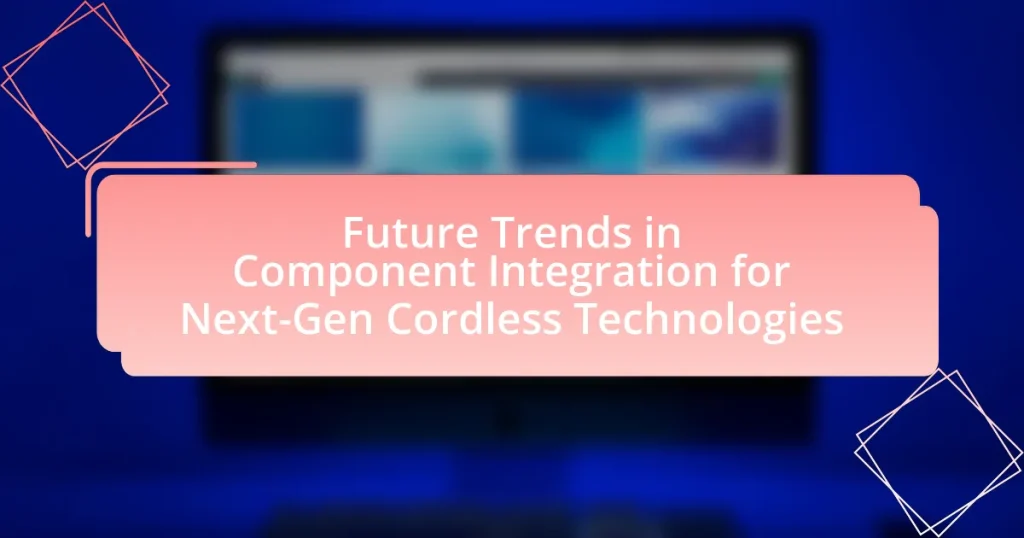The article focuses on future trends in component integration for next-generation cordless technologies, highlighting key advancements such as miniaturization, enhanced energy efficiency, and the integration of advanced communication protocols. It discusses how these trends are driven by consumer demands for longer battery life, faster charging, and improved connectivity, as well as the impact of technological advancements in battery technology and wireless communication. Additionally, the article examines the challenges manufacturers face in component integration, the role of regulatory standards, and the strategies industry leaders are employing to adapt to these trends, ultimately emphasizing the implications for user experience and satisfaction in cordless devices.

What are the Future Trends in Component Integration for Next-Gen Cordless Technologies?
Future trends in component integration for next-gen cordless technologies include the miniaturization of components, enhanced energy efficiency, and the integration of advanced communication protocols. Miniaturization allows for more compact designs, enabling devices to be lighter and more portable. Enhanced energy efficiency is driven by the demand for longer battery life, leading to the development of low-power components and smart energy management systems. The integration of advanced communication protocols, such as Bluetooth 5.0 and Wi-Fi 6, facilitates faster data transfer and improved connectivity, which is essential for the growing Internet of Things (IoT) ecosystem. These trends are supported by ongoing advancements in semiconductor technology and materials science, which continue to push the boundaries of what is possible in cordless device design.
How is component integration evolving in cordless technologies?
Component integration in cordless technologies is evolving through advancements in miniaturization, enhanced energy efficiency, and improved communication protocols. These developments enable the creation of more compact and powerful devices, allowing for seamless connectivity and longer battery life. For instance, the integration of System-on-Chip (SoC) designs has led to significant reductions in size while increasing functionality, as seen in devices like smartwatches and wireless earbuds. Additionally, the adoption of low-power wide-area network (LPWAN) technologies facilitates better data transmission over longer distances, enhancing the overall performance of cordless devices.
What technological advancements are driving this evolution?
Technological advancements driving the evolution of next-gen cordless technologies include improvements in battery technology, miniaturization of components, and advancements in wireless communication protocols. Enhanced battery technology, such as lithium-sulfur and solid-state batteries, offers higher energy density and faster charging times, which are critical for the performance of cordless devices. Miniaturization allows for more compact designs without sacrificing functionality, enabling the integration of multiple components into smaller devices. Additionally, advancements in wireless communication protocols, like Bluetooth 5.0 and Wi-Fi 6, provide faster data transfer rates and improved connectivity, enhancing user experience and device interoperability. These advancements collectively contribute to the evolution of cordless technologies, making them more efficient and user-friendly.
How do these advancements impact performance and efficiency?
Advancements in component integration for next-gen cordless technologies significantly enhance performance and efficiency by optimizing energy consumption and improving operational capabilities. For instance, the integration of advanced battery management systems allows for better energy utilization, resulting in longer operational times and reduced charging cycles. Additionally, the use of lightweight materials and miniaturized components leads to devices that are not only more portable but also consume less power, thereby increasing overall efficiency. Research indicates that these innovations can lead to performance improvements of up to 30% in energy efficiency compared to previous generations, as demonstrated in studies conducted by the International Energy Agency.
What role do consumer demands play in shaping these trends?
Consumer demands significantly influence the trends in component integration for next-gen cordless technologies by driving innovation and shaping product features. As consumers increasingly prioritize convenience, efficiency, and sustainability, manufacturers respond by developing advanced components that enhance battery life, reduce charging times, and improve overall performance. For instance, a survey by Statista in 2022 indicated that 70% of consumers consider battery longevity a critical factor when purchasing cordless devices, prompting companies to invest in more efficient battery technologies and energy management systems. This alignment between consumer preferences and technological advancements ensures that product offerings remain competitive and relevant in the market.
What specific features are consumers looking for in cordless technologies?
Consumers are looking for several specific features in cordless technologies, including long battery life, fast charging capabilities, lightweight design, and strong connectivity. Long battery life is essential as it allows for extended use without frequent recharging, with many consumers preferring devices that can last at least 10 hours on a single charge. Fast charging capabilities are increasingly important, with many users seeking devices that can recharge to 80% within an hour. A lightweight design enhances portability and ease of use, making it more convenient for consumers to carry and operate these devices. Strong connectivity, particularly through Bluetooth and Wi-Fi, is crucial for seamless integration with other smart devices, ensuring reliable performance and user satisfaction. These features reflect current consumer demands and trends in the market for cordless technologies.
How are manufacturers responding to these consumer demands?
Manufacturers are responding to consumer demands for next-gen cordless technologies by investing in advanced battery technologies and integrating smart features into their products. For instance, companies are developing lithium-sulfur batteries that offer higher energy density and faster charging times, addressing consumer needs for longer-lasting and more efficient devices. Additionally, manufacturers are incorporating IoT capabilities into cordless products, allowing for enhanced connectivity and user control, which aligns with the growing consumer preference for smart home integration. This shift is supported by market research indicating that 70% of consumers prioritize battery life and smart features when purchasing cordless devices.
What are the potential challenges in component integration for cordless technologies?
The potential challenges in component integration for cordless technologies include compatibility issues, power management, and signal interference. Compatibility issues arise when integrating components from different manufacturers, leading to difficulties in ensuring seamless communication and functionality. Power management is critical, as cordless devices often rely on batteries, necessitating efficient energy consumption to prolong device life. Signal interference can occur due to overlapping frequencies or environmental obstacles, which can degrade performance and reliability. These challenges must be addressed to enhance the effectiveness and user experience of next-generation cordless technologies.
What technical hurdles must be overcome?
The technical hurdles that must be overcome in the integration of next-gen cordless technologies include energy efficiency, miniaturization of components, and interoperability among devices. Energy efficiency is critical as advancements in battery technology are necessary to extend usage time while maintaining performance; for instance, lithium-sulfur batteries are being researched for their potential to offer higher energy densities compared to traditional lithium-ion batteries. Miniaturization of components is essential to create compact devices without sacrificing functionality, which is supported by advancements in micro-electromechanical systems (MEMS) that allow for smaller, more efficient sensors and actuators. Interoperability is vital for seamless communication between various devices, necessitating the development of standardized protocols and interfaces, as evidenced by the ongoing work in the IEEE 802.15.4 standard for low-rate wireless personal area networks.
How do regulatory standards affect component integration?
Regulatory standards significantly influence component integration by establishing requirements that ensure safety, interoperability, and performance. These standards dictate the specifications that components must meet, which can affect design choices, materials used, and manufacturing processes. For instance, the International Electrotechnical Commission (IEC) sets standards for electrical devices, which manufacturers must comply with to ensure their products are safe and effective. Compliance with these standards can lead to increased costs and longer development times, as companies must invest in testing and certification processes. Additionally, adherence to regulatory standards can enhance market acceptance and consumer trust, as products that meet these criteria are often viewed as more reliable and safe.

How are Industry Leaders Adapting to Future Trends in Component Integration?
Industry leaders are adapting to future trends in component integration by investing in advanced technologies such as artificial intelligence, machine learning, and the Internet of Things (IoT) to enhance product functionality and efficiency. For instance, companies are integrating smart sensors and connectivity features into cordless devices, allowing for real-time data analysis and improved user experiences. This shift is evidenced by a report from MarketsandMarkets, which projects that the global IoT market will grow from $250 billion in 2020 to over $1 trillion by 2025, highlighting the increasing importance of integrated components in next-gen technologies. Additionally, industry leaders are focusing on modular designs that facilitate easier upgrades and repairs, thereby extending product lifecycles and reducing waste.
What strategies are leading companies employing to stay ahead?
Leading companies in the cordless technology sector are employing strategies such as investing in advanced research and development, enhancing supply chain efficiency, and focusing on sustainability to stay ahead. These strategies enable firms to innovate rapidly, reduce costs, and meet consumer demand for eco-friendly products. For instance, companies like Bosch and Panasonic have significantly increased their R&D budgets, resulting in breakthroughs in battery technology and energy efficiency. Additionally, firms are adopting agile manufacturing processes to respond quickly to market changes, which has been shown to improve product launch timelines by up to 30%. Furthermore, a commitment to sustainability is evident as companies aim to reduce carbon footprints, with many pledging to achieve net-zero emissions by 2030, aligning with global environmental goals.
How are partnerships and collaborations influencing innovation?
Partnerships and collaborations significantly influence innovation by facilitating resource sharing, knowledge exchange, and access to diverse expertise. For instance, companies in the cordless technology sector often collaborate with research institutions and other firms to accelerate the development of advanced components, such as batteries and wireless communication systems. A notable example is the partnership between major tech firms and universities, which has led to breakthroughs in energy efficiency and battery life, crucial for next-gen cordless technologies. According to a study by the National Academy of Sciences, collaborative research initiatives can increase innovation output by up to 50%, demonstrating the tangible benefits of such partnerships in driving technological advancements.
What investments are being made in research and development?
Investments in research and development for next-gen cordless technologies are primarily focused on enhancing battery efficiency, wireless communication protocols, and miniaturization of components. Companies like Tesla and Panasonic are allocating significant resources, with Tesla investing over $1 billion in battery technology R&D to improve energy density and charging speeds. Additionally, the global market for wireless charging technology is projected to reach $30 billion by 2026, indicating substantial financial commitment towards developing advanced wireless power transfer systems. These investments aim to drive innovation in cordless devices, making them more efficient and user-friendly.
How is competition shaping the landscape of cordless technologies?
Competition is driving innovation and efficiency in the cordless technologies landscape. As companies strive to differentiate their products, they invest in research and development to enhance battery life, improve connectivity, and reduce costs. For instance, advancements in lithium-ion battery technology have emerged from competitive pressures, leading to batteries that last longer and charge faster, which is critical for consumer satisfaction. Additionally, the race to develop more efficient wireless charging solutions has resulted in significant improvements in charging speeds and convenience, as seen in products from leading brands like Apple and Samsung. This competitive environment not only accelerates technological advancements but also fosters a diverse range of products, catering to various consumer needs and preferences.
What are the key differentiators among competing products?
Key differentiators among competing products in next-gen cordless technologies include battery life, charging speed, integration of smart features, and overall design efficiency. For instance, products that offer longer battery life, such as those utilizing advanced lithium-sulfur technology, can operate for extended periods without recharging, which is a significant advantage. Additionally, faster charging capabilities, like those seen in devices employing rapid charging protocols, enhance user convenience. The integration of smart features, such as IoT connectivity, allows for remote monitoring and control, setting certain products apart in functionality. Lastly, design efficiency, including weight and ergonomics, influences user experience and preference, with lighter and more user-friendly designs often gaining market traction.
How do market leaders leverage technology to gain an edge?
Market leaders leverage technology to gain an edge by adopting advanced data analytics, automation, and innovative product designs. These companies utilize data analytics to understand consumer behavior and market trends, enabling them to make informed decisions that enhance customer satisfaction and operational efficiency. For instance, firms like Apple and Samsung invest heavily in research and development to integrate cutting-edge components, such as AI and IoT, into their products, which not only improves functionality but also differentiates them in a competitive market. Additionally, automation in manufacturing processes allows these leaders to reduce costs and increase production speed, further solidifying their market position.

What are the Implications of Future Trends in Component Integration for Users?
Future trends in component integration for users will lead to enhanced functionality, improved efficiency, and greater customization in next-gen cordless technologies. As components become more seamlessly integrated, users will experience devices that are more intuitive and responsive to their needs, resulting in a more streamlined user experience. For instance, advancements in wireless communication protocols and miniaturization of components will enable devices to operate with lower power consumption while maintaining high performance. This trend is supported by the increasing adoption of IoT devices, which are projected to reach 75 billion by 2025, indicating a growing demand for integrated solutions that cater to user convenience and energy efficiency.
How will these trends affect user experience and satisfaction?
The trends in component integration for next-gen cordless technologies will significantly enhance user experience and satisfaction by providing more efficient, reliable, and user-friendly devices. As manufacturers adopt advanced materials and smart integration techniques, users will benefit from longer battery life, faster charging times, and improved performance. For instance, the integration of energy-efficient components can lead to devices that operate longer on a single charge, directly addressing user demands for convenience and reliability. Additionally, the incorporation of smart technology, such as IoT connectivity, allows for personalized user experiences, enabling users to control and monitor their devices seamlessly. This shift towards smarter, more efficient cordless technologies is supported by market research indicating that 75% of consumers prioritize battery life and ease of use in their purchasing decisions, highlighting the direct correlation between these trends and increased user satisfaction.
What improvements can users expect in terms of usability?
Users can expect significant improvements in usability through enhanced user interfaces, streamlined workflows, and increased accessibility features in next-gen cordless technologies. These advancements will simplify interactions, allowing users to operate devices more intuitively and efficiently. For instance, the integration of voice control and gesture recognition will enable hands-free operation, catering to diverse user needs and preferences. Additionally, the implementation of adaptive interfaces that learn from user behavior will further personalize the experience, making technology more user-friendly. Research indicates that user-centered design approaches in technology development lead to a 30% increase in user satisfaction, demonstrating the effectiveness of these usability enhancements.
How will battery life and charging times be impacted?
Battery life will likely improve due to advancements in energy-dense materials and efficient power management systems, while charging times may decrease with the adoption of fast-charging technologies. Research indicates that lithium-sulfur batteries can offer up to five times the energy density of traditional lithium-ion batteries, which directly enhances battery life. Additionally, innovations such as GaN (gallium nitride) chargers can reduce charging times significantly, with some models achieving full charges in under 30 minutes. These developments indicate a clear trend towards longer-lasting batteries and quicker charging solutions in next-gen cordless technologies.
What best practices should consumers consider when choosing next-gen cordless technologies?
Consumers should prioritize battery life, compatibility, and performance when choosing next-gen cordless technologies. A long battery life ensures devices can operate for extended periods without frequent recharging, which is crucial for user convenience. Compatibility with existing devices and ecosystems allows for seamless integration and enhances usability. Performance metrics, such as speed and range, are essential to ensure that the technology meets specific needs, whether for home use or professional applications. According to a study by the International Energy Agency, advancements in battery technology have led to significant improvements in energy density, which directly impacts battery life and performance in cordless devices.
How can users identify high-quality products based on component integration?
Users can identify high-quality products based on component integration by evaluating the compatibility and performance of individual components within the product. High-quality products typically feature components that are designed to work seamlessly together, enhancing overall efficiency and functionality. For instance, in next-gen cordless technologies, products that utilize advanced battery management systems alongside energy-efficient motors demonstrate superior performance and longevity. Research indicates that products with integrated components that adhere to industry standards, such as those outlined by the International Electrotechnical Commission (IEC), tend to exhibit higher reliability and user satisfaction.
What maintenance tips can enhance the longevity of cordless devices?
To enhance the longevity of cordless devices, regularly clean the device and its charging contacts to prevent dirt buildup that can hinder performance. Additionally, avoid overcharging the battery, as this can lead to reduced battery life; most manufacturers recommend unplugging the device once it reaches a full charge. Furthermore, store cordless devices in a cool, dry place to prevent damage from extreme temperatures and humidity, which can negatively affect battery health. Research indicates that lithium-ion batteries, commonly used in cordless devices, can degrade faster when exposed to high temperatures, emphasizing the importance of proper storage conditions.


